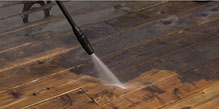The day you finish installing a deck or other wooden structure is the day that trouble can start! Most of our customers think of trouble in the form of damage caused by water or cold, water will penetrate the wood, then as freezing occurs the water will expand leading to deep splinters or cracks.
But what causes deck cracking to begin with? Within 30 days of installation, the sun’s harmful ultra-violet rays causes surface “graying”. The gray color is indicative of wood fiber degradation on the surface, and this graying will grow darker as years of sun exposure take their toll. Like sun-burnt skin, the grayed surface layer is permanently damaged, and must be removed to get to the sound, healthy layers underneath. A “grayed” surface not only signals the beginning of structural damage, it is often times considered unattractive by homeowners.
After a deck is pressure washed to remove the gray, it is important to use a stain (lasts up to 36 months) and has UV protection or a clear seal (lasts up to 12 months) little to NO UV protection. Not only will these protectants restore and enhance your decks beauty, but it will act as a “sun tan lotion” to prevent future cracking, drying, warping, graying. We look forward to helping your deck beat the heat and protect your deck from a sun burn.
When it comes to ugly or failing existing stains, one common thought is just put a solid over it as a solid will cover many flaws. Not exactly, for any stain to last you have to prepare the surface first. In the case of an existing solid, if any part is chipping, bubbling and failing, any stain you put on top will also fail unless you strip and sand the deck correctly or the new solid stain will fail also.
Why strip?
- You don’t like the existing color.
- The existing paint is failing
- HOA doesn’t allow the color you currently have
- You want to go back to a natural look
What’s involved?
- Preparation! Stripping can quickly become a mess unless siding, plants, furniture anything that can be damaged is either covered or removed from the surrounding deck.
- Stripping is a chemical process that delaminates exisiting solid and semi transparent stains from the decking. It also softens the wood and lifts the fibers of the deck.
- Neutralize the deck. Remember back in chemistry the ph scale. Water being neutral at 7, base or alkaline chemicals being greater than 7. Bases are slippery and taste bitter. Strong bases can cause burns on skin, weak bases are used in soaps. Acids have a ph less than 7 they have hydrogen in them, salt vinegar are common acids we use.
The stripping agent we use is a very strong base, if we don’t neutralize the deck then any new stain we apply will continue to be eaten up by the stripper that remains in the deck.
- Sanding, stripping raises the grain of the deck so in every stripping job we do, we must sand the deck afterward to ensure all the rough areas are smooth
Benefits
Stripping saves you money from deck replacement
Take away
As the stripper is applied, it turns the deck bright orange, at that point it is difficult to tell what is removed and what remains. For this reason sometimes a second service visit is required. Some stains are so ingrained in the wood, they cannot be stripped out in parts without damaging the wood. Our motto is the same as a medical doctors Hippocratic oath, first do no harm. For this reason we NEVER guarantee 100% removal of the deck stain.


Recent Comments